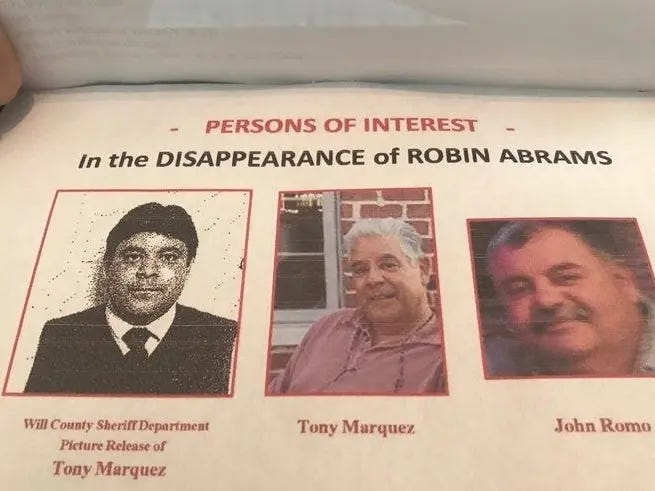The Vanishing of Deputy Robin “Rob” Abrams: A Case Still Haunting Illinois
On October 4, 1990, Robin Abrams, a 28-year-old former Will County Sheriff’s deputy, disappeared without a trace. Her abandoned car, her scattered belongings, and her unresolved lawsuit against the sheriff’s office paint a tangled picture of betrayal, intimidation, and possible conspiracy. More than three decades later, her fate remains one of Illinois’s most persistent cold cases.
Robin Abram’s Background and Career
Robin Abrams pursued a career in law enforcement and joined the Will County Sheriff’s Department in Illinois. She brought determination and ambition to the job, but her future in law enforcement was derailed by a relationship that would eventually lead to conflict, legal battles, and suspicion.
Robin entered into a relationship with auxiliary deputy Antonio “Tony” Marquez, a married man and local businessman. Her family later said she believed he was divorced when they began dating. The relationship turned unstable and hostile. After it ended, Robin alleged that Marquez began harassing and stalking her. Soon after, she lost her job with the sheriff’s department under circumstances she believed were retaliatory.
In 1989, she filed a federal lawsuit alleging wrongful termination, sexual harassment, and civil rights violations against Marquez and officials within the Will County Sheriff’s Department, including Sheriff John Johnsen and several deputies. She claimed her firing was retaliation for ending her relationship with Marquez and for reporting harassment.
Her deposition in that lawsuit was scheduled just weeks after she vanished.
The Day She Disappeared
On the afternoon of October 4, 1990, Robin was last seen by her father as they passed each other driving in opposite directions on Goodenow Road near Beecher, Illinois. Later that day, her red Dodge Daytona was found abandoned in Harvey, Illinois, parked outside an apartment complex. The car was locked, the keys were still in the ignition, and her camera was found inside. Three days later, her purse was discovered in an alley several blocks away, but her identification and credit cards were missing.
A witness reported seeing two men parking Robin’s car and leaving the scene in a tow truck. Authorities never publicly confirmed who those men were or why the car would have been abandoned in that location. Harvey, at that time, was known for its high crime rate, making it a plausible dumping location to mislead investigators.
Robin Abrams was never seen again.
Suspicion and Early Investigation Problems
From day one, Robin’s family believed foul play was involved. They were certain she didn’t disappear voluntarily—she had been actively fighting her wrongful termination case and had left behind all her personal belongings. She also had made plans for the future.
The original investigation was conducted by the Will County Sheriff’s Office—the same agency she had been suing. To outsiders, this represented an obvious conflict of interest. Public criticism mounted, and eventually, the Illinois State Police assumed control of the investigation.
Even so, key evidence went missing, leads weren’t pursued fully, and the investigation stalled. For decades, no one was charged, and no definitive answers emerged.
A Troubled Timeline
Robin’s lawsuit against Marquez and the sheriff’s office created tension within law enforcement circles. Her family reported that she feared for her safety in the months before she disappeared. She was also scheduled to testify under oath—something that could have exposed misconduct and embarrassed powerful people.
Adding to suspicion, Robin had reported more than a dozen incidents involving Marquez in the months before she vanished. She told friends and family she believed she was being followed and that her phone was being tapped. She even documented alleged harassment in a detailed journal.
Shortly after she went missing, a judge dismissed her lawsuit due to her inability to appear. With her disappearance, the case against those she accused evaporated.
New Efforts and a Startling Search
The case sat stagnant throughout the 1990s and early 2000s. Robin’s sister, Jody Walsh, refused to let it be forgotten. She contacted investigators, reached out to media, and demanded accountability.
In 2014, a grand jury heard testimony regarding Robin’s disappearance, which brought renewed hope to the family. However, the proceedings remained sealed, and no charges followed.
Then, in 2017, a major breakthrough appeared possible. Acting on a new lead, investigators executed a search warrant on a Joliet property linked to one of Marquez’s relatives. The basement of the home was broken open as forensic teams and excavators searched beneath newly poured concrete.
The concrete had reportedly been laid in late 1990—after Robin’s disappearance. The man who poured it? Tony Marquez’s stepbrother.
Investigators never revealed what they found, if anything. The search ended without any arrests, and public information about the results remains minimal.
Central Figures in the Case
Two names have remained at the center of suspicion for decades:
Tony Marquez
Marquez, the former auxiliary sheriff’s deputy who had a turbulent relationship with Robin, has long been viewed as a person of interest. He has refused media interviews and has never publicly commented on the case. Family members and retired investigators remain convinced Marquez had both motive and opportunity.
John Romo
Marquez’s stepbrother reportedly poured the concrete in the basement of the home searched in 2017. Rumors circulated for years that Robin might be buried there. Nothing publicly reported ties him directly to Robin’s disappearance, but he has remained of interest to observers.
Potential Cover-Up Allegations
The Abrams family has long believed the investigation into Robin’s disappearance was hindered by corruption. They say law enforcement closed ranks to protect their own. Retired law enforcement officials have echoed those suspicions, suggesting important leads were ignored.
The case was mishandled in several key ways:
The original investigators were from the same department she accused in her lawsuit.
Promising witnesses were never subpoenaed.
Offers of help from outside forensic teams were rejected.
Investigative records were inaccessible to her family for decades.
Important physical evidence was not properly preserved.
A retired Will County lieutenant who continued investigating the case long after retirement publicly criticized how it was handled and suggested a homicide had occurred.
Why No Charges Have Been Filed
One major barrier in this case is the lack of physical evidence—most notably, Robin’s body has never been found. Without remains or forensic evidence, prosecutors have hesitated to move forward.
However, “no body” prosecutions are possible. Many homicide cases have gone to trial and won convictions based on circumstantial evidence. Robin’s family believes that authorities simply haven’t had the will to move forward—and that fear of political fallout still looms over this case.
Theories About What Happened
Several theories exist about Robin’s disappearance:
She was abducted and murdered to silence her before her civil deposition.
Her disappearance was planned in advance and involved multiple people.
Evidence was strategically destroyed or buried.
Her body was hidden beneath concrete and possibly moved before a public search.
Law enforcement collusion delayed meaningful investigation.
Robin’s sister believes the motive is clear: her lawsuit threatened reputations and careers, and eliminating her stopped the legal process.
A Family’s Relentless Search for Truth
More than 30 years later, Robin’s family is still fighting. Her sister Jody has become a symbol of persistence in cold case advocacy. She continues to speak out publicly, maintain pressure on investigators, and call for justice.
She often says:
“I don’t care how long it takes—I will bring my sister home.”
She has also urged potential witnesses to come forward, reminding them it’s never too late to do the right thing.
A Cold Case in Need of Heat
Robin Abrams was a deputy sworn to uphold the law—yet she has been denied justice for decades. Her case is not just about one missing woman. It reflects a failure of investigative integrity, a potential abuse of power, and the dangers faced by whistleblowers inside law enforcement.
Her disappearance remains unsolved. Her body has never been found. No one has been charged.
But the case is still open. And someone knows what happened.
A Case That Needs Solved
The disappearance of Robin Abrams is one of the most compelling and disturbing cold cases in Illinois history. She did not simply vanish. She was involved in a volatile legal battle with members of law enforcement. She feared for her life. She was about to testify against powerful people. And then she was gone.
The truth still exists. Someone still holds the missing piece. And as long as Robin’s family continues to fight, her story will not fade.
If you know anything about what happened to Robin Abrams, no matter how small, you can still come forward. You can still help bring her home.
Justice delayed does not have to be justice denied












